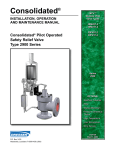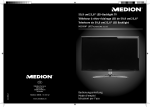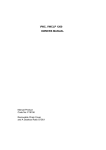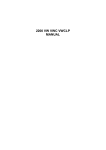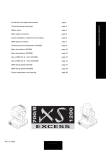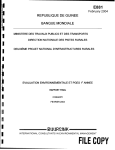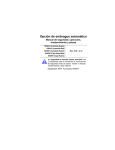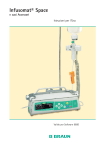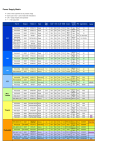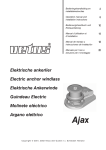Download 3500 VWC VWCLP Pre 2008
Transcript
VWC, VWCLP 3500 Owners Manual © COPYRIGHT 1991 MAXWELL MARINE LTD ALL RIGHTS RESERVED. PATENTS PENDING. PRINTED IN NEW ZEALAND. Product Manual Code P19073 050406 MAXWELL MARINE reserve the right to make engineering refinements on all products without notice. Illustrations and specifications not binding as to detail. VWC/VWCLP 3500 OWNERS MANUAL Page Number CONTENTS INTRODUCTION SPECIFICATIONS 1 2 3-4 IMPORTANT PERSONAL SAFETY WARNINGS APPLICATION INSTALLATION LOCATION - WINDLASS - CHAIN STOPPER - FOOTSWITCHES - REVERSING SOLENOID - BREAKER/ISOLATOR PANEL - CONTROLS CONTROL CIRCUITS MAIN ELECTRICAL SYSTEM HYDRAULIC SYSTEMS PREPARATION OF MOUNTING PREPARING THE WINDLASS MOUNTING THE WINDLASS OPERATION OF THE CONTROL SYSTEM OPERATING THE WINDLASS MAINTENANCE SERVICING OF GEARBOX SERVICING OF MOTOR ORDERING SPARE PARTS AND TECHNICAL SUPPORT 5-7 8 9 9 10 10 11 11 11 12 12-13 14 15 15-16 16-18 18 19-22 23 24 24 25 INSTALLATION DRAWINGS VWC 3500 VWCLP 3500 Deck Cutout details WIRING DIAGRAM (DUAL DIRECTION) WIRING DIAGRAM (SINGLE DIRECTION) HYDRAULIC CONTROL DIAGRAM HYDRAULIC SCHEMATIC B203047 B203048 B203045 B203046 3338 B3424 B3555 B203101 P101820 26-27 28-29 30 31 32 33 34 P102462 35 36-37 38-39 B203099 B203100 B202039 40-41 42-43 44-45 ASSEMBLY DRAWINGS VWC 3500 Typ. Install Drawing VWC 3500 ACW Assembly VWC 3500 CW Assembly VWCLP 3500 ELECTRIC VWCLP 3500 HYDRAULIC GEARBOX WARRANTY REGISTRATION 1 INSTALLATION, OPERATING INSTRUCTIONS AND SERVICE MANUAL VWC 3500 AND VWCLP 3500 WINDLASSES INTRODUCTION You now own a Windlass from MAXWELL’S premier range, designed for automatic anchor handling. The compact deck saving vertical design allows 180º wrap of the chain ensuring maximum engagement with the chainwheel. On VWC types a vertical drum allows working of mooring or docking lines from any direction. A clutch allows manual control for lowering the anchor under free fall and manual override when using the emergency crank. The clutch also allows independent operation of the drum on VWC types. ** IMPORTANT ** FAILURE TO ADHERE TO THE CORRECT APPLICATION, INSTALLATION, OPERATION AND TO CARRY OUT THE MAINTENANCE SERVICE AS DESCRIBED HEREIN, COULD JEOPARDISE YOUR SAFETY AND INVALIDATE THE WARRANTY. Your MAXWELL Windlass is a precision engineered product. Please read these instructions carefully. 2 SPECIFIATIONS PULL AT CHAINWHEEL CHAIN SIZE LINE SPEED AT NORMAL WORKING LOAD,HYD LINE SPEED AT NORMAL WORKING LOAD,12VDC LINE SPEED AT NORMAL WORKING LOAD,24VDC POWER OPTIONS VWC 3500 100mm (4”) Deck Clearance 200mm (8”) Deck Clearance VWCLP 3500 100mm (4”) Deck Clearance 200mm (8”) Deck Clearance ELECTRIC MODELS Current at Normal Working Load 12 Volt 24 Volt 1590 kg Max (3500 lbs) Short Link Max 14mm (9/16”) 12Metres/min (39 feet/min ) 8.7Metres/min (29 feet/min ) 11Metres/min (36 feet/min ) Product Code P10086 P10088 P14076 P10096 P10098 P14085 12 Volt DC 24 Volt D.C. Hydraulic 12 Volt DC 24 Volt DC Hydraulic P12091 P12093 P14091 P12096 P12098 P14095 12 Volt D.C. 24 Volt D.C. Hydraulic 12 Volt DC 24 Volt DC Hydraulic 130-160 Amps 66-82 Amps Current at Stall 12 Volt 24 Volt 450 Amps 220 Amps SUPPLY CABLES See Pages 13-14 * HYDRAULIC MODELS Recommended Flow Maximum Flow Maximum Pressure Hydraulic Supply Lines Hydraulic Motor Ports Oil 40 Litre/min (11 US Gal/min) 48 Litre/min (13 US Gal/min) 138 BAR (2000 p.s.i.) 12mm (½”) diameter 7/8” UNF st’d motor (options ¾” UNF) Viscosity ISO 32 - ISO 68 @ 20-50ºC Suitable oils: Shell Rimula X 15W-40; Shell Myrina M 15W-40; Penzoil SAE 10W-40; Texaco 2109 SAE 15W; Texaco 1814 SAE 10W-40. BP HLPHM 32-68; Castrol Hyspin AWS T0410. * Levels of flow/pressure below that specified can be accommodated with a motor change - see options page 5. Motor Option Max Flow/Min Lt US Gal Max Pressure Bar P.S.I. Max Kg P14367 P14366 P14365 30 25 15 138 138 138 1430 3150 1160 2550 565 1240 8.3 7.0 4.0 2000 2000 2000 3 Pull Lbs Normal Rate/Min Metres Feet 12 12 12 39 39 39 WEIGHT (Nett including Emergency Crank) VWC 3500 Product Code KGS LBS 100mm (4”) Deck Clearance P10086 P10088 P14076 P10096 P10098 P14085 48.3 48.3 40.1 49.3 49.3 41.1 106.3 106.3 88.3 108.5 108.5 90.5 P12091 P12093 P14091 P12096 P12098 P14095 43.2 43.2 35.0 44.2 44.2 36.0 95.1 95.1 77.0 97.3 97.3 79.2 200mm (8”) Deck Clearance VWCLP 3500 100mm (4”) Deck Clearance 200mm (8”) Deck Clearance 4 IMPORTANT PERSONAL SAFETY WARNINGS WHEN USING YOUR WINDLASS AT ALL TIMES PRACTICE GOOD SEAMANSHIP AND AVOID ANY LIKELIHOOD OF INJURY OR ACCIDENT BY ADHERING TO THE FOLLOWING RULES. AT ALL TIMES KEEP HANDS, FEET, LOOSE CLOTHING AND HAIR WELL CLEAR OF THE WINDLASS. NEVER USE THE WINDLASS UNDER POWER WITH THE LEVER INSERTED EITHER IN THE CLUTCH NUT OR EMERGENCY CRANK COLLAR. WHEN OPERATING THE CHAINWHEEL PAWL, KEEP FINGERS AWAY FROM THE INCOMING CHAIN. OPERATE USING THE LEVER UNDER, AND GUARDED BY, THE CHAINPIPE. WHEN THE WINDLASS IS NOT IN USE, OR WHEN USING THE EMERGENCY CRANK, MAKE SURE THE WINDLASS IS ISOLATED FROM THE POWER SUPPLY BY TURNING THE WINDLASS ISOLATOR SWITCH TO “OFF”. NEVER OPERATE THE WINDLASS FROM A REMOTE STATION WITHOUT A CLEAR VIEW OF THE WINDLASS AND HAVING MADE SURE THAT EVERYONE IS WELL AWAY FROM THE WINDLASS. IF YOUR WINDLASS DOES NOT HAVE A REMOTE CONTROL STATION AND IS OPERATED FROM THE FOOTSWITCHES ONLY, ALWAYS IMMEDIATELY AFTER USE, TURN THE WINDLASS ISOLATOR SWITCH TO “OFF”. THIS WILL PREVENT ACCIDENTAL WINDLASS OPERATION IF YOU OR PASSENGERS ACCIDENTALLY STAND ON FOOTSWITCHES. 5 ** IMPORTANT HINTS FOR SAFE USE OF WINDLASS ** BE SURE YOUR WINDLASS HAS BEEN CORRECTLY SPECIFIED AND INSTALLED, YOURS AND OTHERS SAFETY MAY DEPEND ON IT. THE WINDLASS SHOULD BE USED IN CONJUNCTION WITH A CHAINSTOPPER OF THE APPROPRIATE SIZE. FOR AUTOMATIC OPERATION TO BE POSSIBLE, THE ANCHOR MUST BE SELF LAUNCHING. MAXWELL WILL NOT IN ANY WAY BE HELD RESPONSIBLE FOR SELECTION OF A WINDLASS BY OTHERS, INCLUDING DISTRIBUTORS AND AGENTS. IF IN DOUBT, SEND FULL DETAILS OF YOUR CRAFT TO OUR SALES DEPARTMENT FOR APPRAISAL AND WRITTEN RECOMMENDATION. 1. Run the engine whilst raising or lowering the anchor. Not only is this a safety precaution, it also helps minimise the drain on the batteries. 2. Always motor up to the anchor while retrieving the chain. Do not use the Windlass to pull the boat to the anchor. 3. If the anchor is fouled, do not use the Windlass to break it out. With the chainstopper taking the load, use the boats engine to break the anchor loose. 4. Do not use the Windlass as a Bollard. In all but the lightest conditions, engage the chainstopper after completing the anchoring manoeuvre. 5. In heavy weather conditions, always use a heavy anchor snub from the chain directly to a Bollard or Sampson Post. 6. DO NOT USE THE CHAINSTOPPER OR WINDLASS AS A MOORING POINT. 7. ALWAYS TURN THE ISOLATOR SWITCH TO “OFF” BEFORE LEAVING BOAT. 8. When using the Windlass DO NOT SWITCH IMMEDIATELY FROM ONE DIRECTION TO THE OTHER WITHOUT WAITING FOR THE WINDLASS TO STOP AS THIS COULD DAMAGE THE WINDLASS. Abuse is not covered by Warranty. 9. The Circuit Breaker and Isolator Switch Panel provides high current protection for the main supply cables and also the means to isolate the circuit. When the Isolator Switch is “ON” (red indicator light shows) the system can be activated at either the footswitches or the remote control station. When the system is not being used, ensure that the Isolator Switch is turned “OFF”. 10. Never proceed at speed with a bow mounted self launching anchor in position, without first ensuring that your winch clutches are fully engaged, and having made fast the anchor and engaged your chainstopper. 6 DO NOT DEPEND ON THE WINDLASS TO HOLD THE ANCHOR IN ITS BOW ROLLER. A NYLON LINE SHOULD BE USED TO SECURE THE ANCHOR INTO ITS STOWED POSITION WHEN UNDERWAY AND WILL NEED TO BE REMOVED BEFORE OPERATION OF THE WINDLASS. ALTERNATIVELY, A PIN THROUGH THE BOW ROLLER AND THE SHANK OF THE ANCHOR CAN BE USED FOR SECURING. Most Windlass models have clutches for the manual pay out of ground tackle in the event of a loss of power. It is therefore prudent to secure the anchor to the boat by the means described above. 7 APPLICATION THE MAXWELL VWC AND VWCLP 3500 WINDLASSES ARE DESIGNED FOR ALL CHAIN SYSTEMS USING UP TO A MAXIMUM CHAIN SIZE OF 14MM (9/16”) SHORT LINK CHAIN. To save weight, a smaller size High Tensile Chain may be used. ** WARNING ** BE SURE YOUR WINDLASS HAS BEEN CORRECTLY SPECIFIED BEFORE INSTALLATION, YOURS AND OTHERS SAFETY MAY DEPEND ON IT. MAXWELL WILL NOT IN ANY WAY BE HELD RESPONSIBLE FOR SELECTION OF A WINDLASS BY OTHERS, INCLUDING DISTRIBUTORS AND AGENTS. IF IN DOUBT, SEND FULL DETAILS OF YOUR CRAFT TO OUR SALES DEPARTMENT FOR APPRAISAL AND WRITTEN RECOMMENDATION. Your Windlass should have a rating of approximately 3 times total combined weight of the anchor and chain. The ground tackle should have been selected taking into account: a) Boat size, displacement and windage. b) Conditions of operation such as maximum depth of water, type of bottom and weather conditions. c) Holding power and size of anchor, taking special note of the manufacturers’ recommendations. CHAIN FIT CORRECT FIT OF CHAIN TO CHAINWHEEL IS ESSENTIAL FOR THE WINDLASS TO OPERATE PROPERLY. A range of chainwheels are available to suit your Windlass. The correct fit can only be guaranteed where a standard chain known to us is used. Alternatively a 450mm (18”) or 12 links (whichever is longer) sample must be forwarded to us to match fit. Where patterns to suit are not held by us we are able to manufacture to instructions and reserve the right to charge cost thereof. CHAIN STOPPER THE WINDLASS SHOULD BE USED IN CONJUNCTION WITH A MAXWELL CHAIN STOPPER OF THE APPROPRIATE SIZE. 8 INSTALLATION WHERE TO LOCATE THE WINDLASS Please refer to the installation drawings with these instructions/. The MAXWELL VWC AND VWCLP 3500 Windlasses operate in dual direction power UP/DOWN. On standard installations “UP” is clockwise rotation when looking down on the windlass. Opposite handed chain pipes are available so that handed dual Windlass installations can be made. On the opposite hand Windlass, “UP” would correspond with counter clockwise rotation when looking down on the Windlass. The deckplate should be mounted pointing in the direction of the incoming chain and with the left hand side parallel to the line of the incoming chain. This arrangement allows the chain to have maximum engagement with the chainwheel. The Windlass must be positioned to allow the chain to have a clear run from the fairlead or bow roller on to the chainwheel. The bow roller should have a vertical groove to suit the profile of the chian. This will align the chain so that it enters the chainwheel without twisting. Ideally the outlet from the chainpipe should be directly over the chain locker and the chain should have at least 600mm (2ft) clear fall to allow the chain to straighten before passing through the Windlass. If it can be arranged the chain locker bulkhead should pass between the chainpipe outlet in the deckplate and the Windlass gearbox. This will keep the gearbox, motor and wiring or hydraulic hoses dry and away from flaying chain. Access for servicing from inside the cabin area can usually be arranged through a locker. The chain must gravity feed into the locker. If the chainpipe cannot be positioned directly over the locker, heavy wall flexible plastic pipe can be used to direct the chain to the required area. It is important that the chain slips through easily, completely unaided. It may be necessary to provide the pipe with a bell mouth or to bell mouth the entrance to the chainpipe from the locker to assist the free flow of the chain from the locker. The chain locker must be of such a size that the chain will heap up and feed out naturally without fouling. 9 NOTE: Make sure you securely fasten the end of the chain to the boat. ** IMPORTANT ** FOR AUTOMATIC OPERATION TO BE POSSIBLE, THE ANCHOR MUST BE SELF LAUNCHING. This is, once the Windlass is operated to reverse out the chain, the anchor must free fall, or the bow roller arrangement be such that the anchor is automatically launched. When positioning the Windlass, make sure that there is room to swing the emergency crank so that it will clear the pulpit and life lines or Bulwark Allow access for conveniently connecting the supply lines under deck after the Windlass is bolted in position. It should be noted that the gearbox can be indexed through 4 different positions in relation to the deckplate This can be achieved on installation by referring to the appropriate assembly drawing and indexing at either end of the spacer tube on bolts. Be sure to select the most convenient position and allow for the best run for the chain to clear the motor. WHERE TO LOCATE THE CHAIN STOPPER The chain stopper should be positioned and aligned in a convenient position between the Windlass and the bow roller, so that it clears the anchor stock. The chain should pass through the stopper without being deflected. WHERE TO LOCATE THE FOOTSWITCHES FOOTSWITCHES SHOULD BE POSITIONED FAR ENOUGH AWAY FROM THE WINDLASS TO ENSURE OPERATOR SAFETY. To allow the operator to tail from the warping drum, footswitches should be at least 500mm (20”) from the Windlass. THE BELOW DECK PORTION OF THE FOOTSWITCH SHOULD NOT BE EXPOSED TO WATER OR WET ENVIRONMENT AND THE BREATHER HOLES MUST BE KEPT CLEAR. Ideally, they should be external to the chain locker. The arrows on the footswitches should be arranged to indicate the direction of operation. 10 WHERE TO LOCATE THE REVERSING SOLENOID (Electric Windlass Only) This unit is used ONLY when a Dual Direction control system is being installed. (Refer wiring diagrams). The Reversing Solenoid should be located in a dry area in close proximity to the Windlass. IT MUST NOT BE LOCATED IN THE WET ENVIRONMENT OF THE CHAINLOCKER. Locating close by the Windlass considerably shortens the total length of the main power supply conductors required. WHERE TO LOCATE THE BREAKER/ISOLATOR PANEL (Electric Windlasses Only) The Maxwell Breaker/Isolator Panel is used when either the Dual Direction system or the Single Direction System is used. The Breaker/Isolator Panel is selected to provide limited protection only for the motor and full protection for the supply cables. This unit also provides the means for isolating the electrical system from the battery. This should be mounted in a dry place within 1.8 metres (72”) of cable length from battery. This equipment or equivalent is mandatory to meet U.S.C.G. requirements. WHERE TO LOCATE THE CONTROLS The remote control stations can be positioned as required, i.e. Bridge, Helm, Cockpit or Foredeck to suit your requirements. Mount the panels where the terminals project into a dry area and if mounted in an area where the face is exposed to the weather, i.e. Fly Bridge, the mounting must be bedded down with sealant. They may be wired directly to, or linked together in series to the Reversing Solenoid (Refer wiring diagrams). 11 CONTROL CIRCUITS MAXWELL Windlasses may be installed for single direction or dual direction operation. The control circuits are detailed in Drawings D3555 and B3424. These systems should be wired throughout using 1.55mm² (16 AWG) Cable. A manually resettable ignition proof 3 amp fuse or breaker should be fitted within one metre (40”) of the Breaker/Isolator Panel as shown on Drawing B3424. The above requirements are mandatory for this system to meet USCG, ABYC AND NMMA. After all connections have been made and system tested, seal terminals against moisture by spraying with CRC2043 “Plasti-Coat”, CRC3013 “Soft Seal” or CRC2049 “Clear Urethane”. MAIN ELECTRICAL SYSTEM The main electrical system is a two cable ungrounded fully insulated negative return system. The motor is of the isolated earth type. This system is used to minimise electrolytic and corrosion problems. The system should be wired as per drawing B3424 or B3555, having taken into consideration the best location for the main elements as previously discussed. After all connections have been made and system tested, seal terminals against moisture by spraying with CRC2043 “Plasti-Coat”, CRC3013 “Soft Seal” or CRC2049 “Clear Urethane”. The main supply cables should be selected from the table on the following page. 12 RECOMMENDED MAIN CABLE CONDUCTOR SIZE 12 VOLT D.C. SYSTEMS Conductor Length Battery to Winch Conductor Size Engine Room Size Correction ____________________________________________________________________ Metres 3.1 4.6 6.2 7.7 9.2 10.8 12.3 15.4 Feet 10 15 20 25 30 35 40 50 MM² 34 34 34 42 54 54 67 85 A.W.G 2 2 2 1 0 0 00 000 MM² 42 42 42 - A.W.G 1 1 1 - MM² 13.3 13.3 13.3 13.3 13.3 22.0 22.0 22.0 A.W.G 6 6 6 6 6 4 4 4 MM² 22 22 22 22 22 - A.W.G 4 4 4 4 4 - 24 VOLT D.C. SYSTEMS Metres 3.1 4.6 6.2 7.7 9.2 10.8 12.3 15.4 Feet 10 15 20 25 30 35 40 50 NOTE a) Conductor length means the actual length of the conductor between the battery and Windlass. b) Recommendations allow for a maximum 10% voltage drop approximately over the conductor length. c) Where portion of cable runs through the engine room a size increase should be made as indicated. d) Recommendations assume cable insulation has a minimum thermal rating of 90ºC. e) The above recommendations are in accordance with the requirements of USCG, ABYC AND NMMA. 13 HYDRAULIC SYSTEMS Pressure/flow quoted in specification on pages 4-5 assumes operation at rated capacity with standard motor fitted. Levels below that specified can be accommodated, by a motor change, with a corresponding change to stall torque and/or speed. (Refer chart page 5). Several levels of supply and control are possible. BASIC SYSTEM (Refer Hydrualic diagrams). This covers applications where the Windlass is supplied from an engine driven pump or single function power pack. Control of the Windlass is via a hydraulic bi-directional solenoid valve which is operated by a self centering UP/DOWN toggle switch type remote control or the footswitches. . 14 PREPARATION OF MOUNTING Standard units will accommodate deck thickness up to 100mm (4”). Extra clearance models are available to accommodate deck thickness in the range of 100mm to 200mm (8”). It should be noted that keeping the deck thickness to no more than 75mm (3”) and 175mm (7”) respectively, will considerable enhance serviceability. This will allow access to the gearbox mounting bolts, allowing the gearbox to be removed as a sealed unit, without dismantling the top works. ** IMPORTANT ** 1. IT IS IMPERATIVE THAT THE DESIGNER/INSTALLER ENSURES THAT THE DECK AND UNDERDECK PAD ARE OF SUFFICIENT THICKNESS AND STRUCTURAL STRENGTH TO SUSTAIN THE LOADS CAPABLE OF BEING IMPOSED ON OR BY THE WINDLASS. THE UNDERDECK PAD SHOULD SPREAD THE LOADS AS WIDE AS POSSIBLE AND IF USE CAN BE MADE OF A BULKHEAD OR CROSS MEMBER TO PROVIDE STIFFENING, THIS SHOULD BE DONE. 2. IT IS VERY IMPORTANT THAT THE ABOVE DECK PAD TOP SURFACE OR DECK AREA COVERED BY THE TEMPLATE SUPPLIED, AND THE UNDERDECK AREA AGAINST WHICH THE LOAD WASHERS SEAT, ARE SMOOTH, FLAT AND GENERALLY PARALLEL. 3. A template is supplied with these instructions for accurately spotting the mounting holes and marking the cut outs. After spotting, bore the necessary holes. These must be drilled parallel to each other and square to the mounting face. Note: For boats of steel or aluminium construction, it is very important that the deckplate is insulated from the deck with a non conductive gasket, that the mounting studs pass through insulators and that the underdeck fixings are insulated from the deck. It is also important that the anchor and chain is insulated from the hull, including rubber lining, the chain locker and insulating the fixing for the end of the chain to the hull. Without these precautions severe electrolysis can occur. It is not necessary to separately earth the Windlass, as the electric motor is of the isolated earth type. PREPARING THE WINDLASS Remove the Windlass from the packaging. Subject tot he type of packaging used, the Windlass will be either completely assembled or with the motor separated from the gearbox. Refer to the appropriate assembly drawing provided for the Windlass being installed and proceed as follows: 15 4. If the motor is not fitted to gearbox, assemble it as follows: For Electric Motors Offer motor up to gearbox aligning drive pin with slot in the worm item 20 Drawing B202039. Insert and tighten two bolts item 37 and washers items 38, 39 provided (refer to Assembly Drawings B202097 for VWC types and B202099 for VWCLP types). For Hydraulic Motors Offer motor up to gearbox aligning drive pin with slot in the worm item 20 Drawing 202039. Insert and tighten two bolts item 37, washers items 38, 39 and nuts item 44 provided (refer to Assembly Drawings). 5. With a pen knife, or similar, carefully remove cap, item 1. Remove screw, item 2 and retaining washer, item 3. Unscrew clutch nut, item 4. Lift drum, item 42 from shaft (VWC models only). Undo two Bolts, item 6, with washers item 7 and remove stripper arm item 8, from chainpipe item 13. Lift outer clutch cone, item 5, chainwheel, item 9 and inner clutch cone, item 10 complete with springs and plungers items 46 and 45 from shaft. Remove two keys, item 31 and retaining circlip (two halves), item 32 from shaft, item 30. Lift wave washer item 11 and emergency crank collar item 12 from shaft. 6. Remove washers items 27 and 23, by undoing six nuts item 29. 7. Remove top set of four bolts item 22 with spring washers item 23 and lift deck plate 14 from gearbox. Remove shaft item 30 from gearbox. With gearbox held horizontally, check that oil is showing half way up the sight glass in the gearbox upper half. If necessary, top up with SAE90 (Shell Omala 320, Castrol Alpha SP320 or equivalent). DON’T OVER FILL. MOUNTING THE WINDLASS 8. Clean the underside of the deckplate item 14. Make sure the mounting area on the deck is properly prepared, as per step 3 above and is clean. Using a sealant/bedding compound between the deckplate and the deck, lower the deckplate to the deck, guiding the mounting studs 26 through the pre drilled mounting holes and bed the deckplate down. 16 9. From the underside of the deck offer up washers items 27 and 23 and replace six nuts item 29. IMPORTANT Tighten the nuts progressively and evenly. DO NOT USE POWER TOOLS. Do not overtighten. Ensure installation is firm. 10. Lightly grease shaft item 30, using Marine grease, Lithium based or Lithium complex based, example Duckhams ‘Keenol’; ‘Castrol LMX’. Do not use soap based grease. Feed shaft through the deckplate from below and hold in place by inserting key item 31. Note: If space doesn’t permit access from below, then shaft may be replaced from the top. This will involve removing key item 33 and other circlip item 34. Replace these from the underside once the shaft is installed. Make sure that the circlip is properly located in the upper groove and that the key is properly seated. 11. Slide the gearbox assembly up on the shaft aligning the keyway (this will lift shaft) and locating the spacer tube item 35 on the spigot of the deck plate item 14. Rotate the gearbox assembly to locate on downs Items 21 and 25 in the most appropriate of the four positions available. Replace four bolts and spring washers items 22 and 23 removed in step 7 above. Tighten bolts evenly and firmly - DON’T USE POWER TOOLS. Replace circlip item 34, removed in step 4, in bottom end of shaft, making sure it is properly seated in groove. Remove key item 31 from shaft. 12. Ensure parts removed in step 5 above are clean along with the top area of the deckplate. 13. Using a grease gun charged with grease (specified in 10 above) apply to grease nipple item 24 and grease main bearing. 14. Use grease (specified in step 10 above) and with the aid of a clean brush or nonfluffy rag, lightly grease the thread on the top end of the shaft item 30 and the bores and clutch faces of the parts removed in step 5 above, reassemble them as you go in reverse order. IMPORTANT - care must be taken to ensure that keys 31 are properly seated in shaft and that circlip halves item 32 are properly seated and captivated by inner clutch cone item 10 on re-assembly. 17 IMPORTANT NOTE TO BOAT BUILDERS After completing installation we suggest that you spray the top works of the winch with CRC3097 “Long Life” Also protect the winch by wrapping with plastic film and tape. Experience has shown that on long ocean deliveries as deck cargo sulphur from the ships exhausts settles and severely damages the chrome plating and stainless steel by breaking down the chrome oxide protective film. PLEASE LET YOUR CUSTOMER RECEIVE THE WINDLASS FROM YOU IN THE SAME TOP QUALITY CONDITION THAT YOU RECEIVED IT FROM US. OPERATION OF THE CONTROL SYSTEM DUAL DIRECTION SYSTEM (Refer electrical drawings) This system provides means of controlling the Windlass via a Reversing Solenoid which is actuated by a self centering UP/DOWN toggle switch type remote control or the footswitches. An indicator light on the remote control glows when the power is “ON” and the system can be operated. WARNING: When using the Windlass DO NOT SWITCH IMMEDIATELY FROM ONE DIRECTION TO THE OTHER WITHOUT WAITING FOR THE WINDLASS TO STOP AS THIS COULD DAMAGE THE WINDLASS. Abuse is not covered by Warranty. The Breaker/Isolator Panel provides protection for the main supply cables and means to isolate the circuit. WARNING: When the Isolator Switch is “ON” the system can be activated at either the footswitches or the remote. When the system is not being used, ensure that the Isolator Switch is turned “OFF”. WARNING: This system provides protection for the motor from excessive current and short circuit. It does not provide protection against excessive heat build up due to prolonged operation or repeated operation under overload conditions. Make sure you give the motor time to cool. Abuse is not covered by Warranty. 18 OPERATING THE WINDLASS LOWERING THE ANCHOR UNDER POWER Proceed as follows: 1. Insert the lever, item 41, into the clutch nut item 4 and check that the clutches are tightened down firmly by turning the nut clockwise. REMOVE THE LEVER. 2. Check that the chain stopper is open and the pawl item 17 is disengaged from the chainwheel. NOTE: This may require jogging the Windlass “UP” by momentarily operating the footswitch. 3. If clutches are tightened down and the chain stopper and pawl are disengaged, the Windlass may be operated under power by either using the “DOWN” footswitch or the “DOWN” button on the Remote Control Station. Pulse the winch down to prevent over speeding of the motor. Continue until the required amount of chain is out. RAISING THE ANCHOR UNDER POWER Proceed as follows: 1. Carry out step 1 above. 2. If the clutches are tightened down, the Windlass may be operated under power by either using the “UP” footswitch or the “UP” button on the Remote Control Station. Hold until the required amount of chain has been brought in. Care should be taken when docking the anchor. Jog in the last metre (few feet) carefully seating the anchor home. NOTE: It is not necessary to disengage the pawl or open the chain stopper to operate the Windlass in the “UP” direction. LOWERING THE ANCHOR UNDER MANUAL CONTROL This method is generally used in tight anchorages or an emergency situation, where a fast dump is required. Proceed as follows: 1. Insert the lever item 41 into the clutch nut item 4 and check that the clutches are tightened down firmly by turning the nut clockwise. REMOVE THE LEVER. 2. Check that the chainstopper is open and the pawl item 17 is disengaged from the chainwheel. 19 NOTE: This may require jogging the Windlass “UP” under power or in an emergency by using the emergency crank lever. IF JOGGING UNDER POWER MAKE SURE THAT THE LEVER IS REMOVED FIRST. 3. Standing well clear, insert the lever into the clutch nut. Slowly back off the clutch nut. This will release the chain. Regulate the speed at which the chain goes out by tightening to slow, or easing to increase. ** CAUTION ** DO NOT ALLOW THE CHAINWHEEL TO FREE WHEEL AS THIS WILL ALLOW DANGEROUSLY HIGH CHAIN SPEEDS TO BUILD UP. 4. When the required amount of chain is out, tighten the clutch nut firmly, remove the lever and stow. 20 RAISING THE ANCHOR MANUALLY IN AN EMERGENCY An emergency crank facility for raising the anchor is provided. To use proceed as follows: 1. Check that the chainstopper is engaged. If a chainstopper is not fitted ensure that the pawl item 17 is engaged with the chainwheel. 2. Insert the lever in the clutch nut and release clutches by backing off the clutch nut in a counter clockwise direction. 3. Insert the ratchet lever into the emergency crank collar item 12, and engage pawl with one of the dogs in the chainwheel in the furthermost forward position. 4. Take the weight by pulling the lever back as far as possible, bring in the chain. Ease off and the pawl will take the load. Push lever to furthermost forward position and re-engage with the chainwheel. Repeat cycle, progressively bring in the anchor. NOTE: If a chainstopper is not fitted, or if found more convenient, the pawl item 17 may be engaged with the chainwheel after each upward (clockwise) movement to hold the chainwheel from reversing. Engage pawl by using lever under the chainpipe. USING THE WARPING DRUM (VWC Models only) The vertical Capstan can be used independently of the chainwheel. This is ideal for handling mooring lines, docking lines or a second anchor. To use proceed as follows: 1. Check that the pawl item 17 is engaged with the chainwheel. 2. Insert the lever item 41 in the clutch nut item 4 and back off in a counter clockwise direction until it stops. The Capstan will now operate whilst the chainwheel remains stationery. 3. Take several turns of line around the drum in a clockwise direction. Whilst pulling on the tail press the “UP” footswitch. The Capstan will rotate in a clockwise direction. Increasing or decreasing the load on the tail, whilst holding the footswitch down will increase/decrease the rate at which the line will be hauled in. 21 Extra turns around the drum will increase the grip and require less load on the tail. CAUTION: ENSURE THAT FOOTSWITCH IS NOT OPERATED ACCIDENTALLY WHILST EXTRA TURNS ARE BEING TAKEN. KEEP FINGERS CLEAR. DON’T PUT SO MANY TURNS ON THE DRUM THAT EASING THE LOAD ON THE TAIL WILL NOT ALLOW THE ROPE TO SLIP ON THE DRUM. 22 MAINTENANCE ** IMPORTANT ** Failure to carry out the maintenance and service as described herein will invalidate warranty. Recommended Lubricants Gearbox Oil: SAE 90, e.g. Shell Omala 320, Castrol Alpha SP 320. Mainshaft & Bearing: Marine grease, lithium based or lithium complex based, e.g. Duckhams ‘Keenol’; ‘Castrol LMX’. Do not use soap based grease. Above Deck Components: CRC 3097 Spray 1. Prior to Season - the above deck components should be removed and greased following the instructions under steps 5, 12, 13 and 14 of the installation instructions. Check level of oil in gearbox. If necessary top up as per step 7 of preparing the windlass instructions. The underdeck components should be sprayed, preferably with CRC3097 “Long Life” or alternatively, CRC6-66 or WD40. Particular attention should be paid to the motor on electric units, including the motor terminals, footswitch terminals, terminals on the Reversing Solenoid Pack or the Overload/Control Box plus the battery and isolator terminals. 2. Bi-monthly throughout the Season - grease the main bearing as per step 13 of the installation instructions. 3. Six monthly - repeat procedure under item 1 above. 4. End of Season - before storage carry out procedure under item 1. 5. Above deck components - clean the Windlass with a cloth damp with Kerosene (paraffin). Spray preferably with CRC3097 “Long Life” or alternatively, CRC6-66 or WD40. Polish off with a clean non-fluffy cloth. Regular use of CRC3097 “Long Life” will assist maintaining the bright chrome finish. Natural lustre of bronze units can be restored by polishing with mild abrasive liquid polish. Don’t use on chrome units. 23 SERVICING OF GEARBOX The gearbox is a totally self contained sealed unit. Providing the Windlass is not abused this unit should give years of trouble free service. Every three years the gearbox should be removed, oil drained, cleaned and oil replaced with SAE 90, e.g. Shell Omala 320, Castrol Alpha SP 320. If further maintenance is required, refer to drawing B202039 and accompanying parts list, for disassembly. SERVICING OF MOTOR - Electric Units If necessary, the motor can be removed from the gearbox without draining the gearbox oil as the gearbox is a sealed unit. The motor is removed by undoing two bolts item 37 and washers items 38 and 39 (refer to assembly drawing B203097 for VWC types and B203099 for VWCLP types). A replaceable drive pin item 40 is a press fit in the output end of the drive shaft. This pin engages the slot in the worm item 20 drawing B202039. Providing the Windlass is properly installed with the Maxwell Overload Control Box and Breaker Panel, and the Windlass is not abused, trouble free operation can be expected. Replacement brush sets are available - order Part No. S.P. 1383 - 12 Volt, Part No. S.P. 1384 - 24 volt. SERVICING OF MOTOR - Hydraulic Units If necessary, the motor can be removed from the gearbox without draining the gearbox oil as the gearbox is a sealed unit. The motor is removed by undoing two bolts, item 37, washers items 38 and 39, and nuts item 44. (Refer assembly drawings). 24 ORDERING SPARE PARTS AND TECHNICAL SUPPORT Please refer back cover for your nearest MAXWELL distributor or visit our website www.maxwellmarine.com. When ordering spare parts and for technical support, please quote the following: Windlass Model……………………………. Serial Number……………………………… Power Supply 12V, 24V or Hydraulic Drawing Reference Number…………….. Item No……………………………………… Part No……………………………………… Description………………………………… Quantity Required………………………… 25 26 27 28 29 30 31 32 33 34 35 36 37 38 39 40 VWCLP 3500 ELECTRIC ITEM PART NO. 1 2 3 4 5 6 7 8 9 10 11 12 13/A 13/B 14 15 16 17 18 19 20 21 22 23 24 25 26/A 26/B 27 28 29 30/A 30/B 31 32 33 34 35/A 35/B 36 37 38 39 40 41 42/A 42/B 43 44 45 46 47 E3227 SP40 E3267 C3181 D3185 SP254 E3856 E1509 C3182 C3184 SP468 C3158 C3191 C3192 B1506 SP167 E3435 E2324 SP463 SP871 E3205 E3188 SP287 SP457 E2048 E3175 E3174 E3217 SP423 SP322 C3206 C3218 E3207 E2311 E3150 SP846 C3169 C3204 P12063 SP288 SP413 SP467 SP530 P20040 P10156 P10157 E3569 E3570 SP2484 DESCRIPTION B203099 QTY CAP SCREW - CSK ST. ST. 3/8” x 1” LG RETAINING WASHER CLUTCH NUT CLUTCH CONE - OUTER BOLT - HEX HD M8 X 20 LG ST. ST. LABEL STRIPPER ARM CHAINWHEEL CLUTCH CONE INNER WAVE SPRING WASHER SSR-0187-S17 EMERGENCY CRANK COLLAR CHAINPIPE - CLOCKWISE UP - STANDARD AS SHOWN CHAINPIPE - ANTICLOCKWISE - OPTIONAL DECK PLATE CAP SCREW SOC. HD. M8 X 20 LG ST.ST. PAWL PIN PAWL WAVE SPRING WASHER SSR-0100-S17 SPIRAL RETAINING WASHER PLUG STOP PIN BOLT - HEX HD 3/8” x 1 ¼” LG ST.ST. WASHER - SPRING 3/8” ST.ST. GREASE NIPPLE DOWEL STUD (4” TDC) STUD (8” TDC) WASHER 1 1 1 1 1 2 1 1 1 1 1 1 1 1 1 4 1 1 1 1 1 1 4 14 1 3 6 6 6 NUT - HEX 3/8” ST. ST. MAINSHAFT (4” TDC) MAINSHAFT KEY CLUTCH RETAINING CIRCLIP KEY CIRCLIP - EXT. DIAM. 1 ½” Shaft ST. ST. SPACER TUBE (4” TDC) SPACER TUBE (8” TDC) GEARBOX ASSY BOLT - HEX HD M8 x 25LG ST. ST. WASHER - 5/16” ST. ST WASHER - SPRING 8mm ST. ST. ROLL PIN EMERGENCY CRANK LEVER MOTOR 12 V MOTOR 24V 6 1 1 1 1 1 2 1 1 1 2 4 2 1 1 1 1 PLUNGER SPRING CAP SCREW 4 4 4 41 42 VWCLP 3500 HYDRAULIC ITEM PART NO. 1 2 3 4 5 6 7 8 9 10 11 12 13/A 13/B 14 15 16 17 18 19 20 21 22 23 24 25 26/A 26/B 27 28 29 30/A 30/B 31 32 33 34 35/A 35/B 36 37 38 39 40 41 42 43* 44 45 46 47 * DESCRIPTION B203100 QTY E3227 CAP 1 SP40 SCREW - CSK ST. ST. 3/8” x 1” LG 1 E3267 RETAINING WASHER 1 C3181 CLUTCH NUT 1 D3185 CLUTCH CONE - OUTER 1 SP254 BOLT - HEX HD M8 X 20 LG ST. ST. 2 E3856 LABEL 1 E1509 STRIPPER ARM 1 C3182 CHAINWHEEL 1 C3184 CLUTCH CONE INNER 1 SP468 WAVE SPRING WASHER SSR-0187-S17 1 C3158 EMERGENCY CRANK COLLAR 1 C3191 CHAINPIPE - CLOCKWISE UP - STANDARD AS SHOWN 1 C3192 CHAINPIPE - ANTICLOCKWISE - OPTIONAL 1 B1506 DECK PLATE 1 SP167 CAP SCREW SOC. HD. M8 X 20 LG ST.ST. 4 E3435 PAWL PIN 1 E2324 PAWL 1 SP463 WAVE SPRING WASHER SSR-0100-S17 1 SP871 SPIRAL RETAINING WASHER 1 E3205 PLUG 1 E3188 STOP PIN 1 SP287 BOLT - HEX HD 3/8” x 1 ¼” LG ST.ST. 4 SP457 WASHER - SPRING 3/8” ST. ST. 14 E2048 GREASE NIPPLE 1 E3175 DOWEL 3 E3174 STUD (4” TDC) 6 E3217 STUD (8” TDC) 6 SP423 WASHER 6 SP322 NUT - HEX 3/8” ST. ST. 6 C3206 MAINSHAFT (4” TDC) 1 C3218 MAINSHAFT (8” TDC) 1 E3207 KEY 1 E2311 CLUTCH RETAINING CIRCLIP 1 E3150 KEY 1 SP846 CIRCLIP - EXT. DIAM. 1 ½” Shaft ST. ST. 2 C3169 SPACER TUBE (4” TDC) 1 C3204 SPACER TUBE (8” TDC) 1 P12063 GEARBOX ASSY 1 SP279 BOLT 2 SP413 WASHER - 5/16” ST. ST 6 SP467 WASHER - SPRING 8mm ST. ST. 2 SP530 ROLL PIN 1 P20040 EMERGENCY CRANK LEVER 1 P14368 MOTOR HYDRAULIC (STANDARD MGG - 200-25) 1 SP366 NUT - HEX M8 ST. ST. 2 E3569 PLUNGER 4 E3570 SPRING 4 SP2484 CAP SCREW OPTIONAL (SEE SPECIFICATIONS) P14367 = MGG - 200-20 P14366 = MGG - 200-16 P14365 = MGG - 200-10 43 44 GEARBOX ASSY ITEM PART NO. 1 2 3 4 5 6 7 8 9 10 11 12 13 14 15 16 17 18 19 20 21 22 23 24 25 26 27 28 B3135 E3168 E3146 B3134 D3225 SP650 E3141 D3226 SP644 SP722 SP172 SP726 E3170 D3137 E3288 E3287 SP838 E3145 SP643 D3140 SP642 SP844 SP721 C3136 SP159 SP720 D3263 D3223 DESCRIPTION GEARCASE - UPPER BUSH BUSH GEARCASE - LOWER GEAR & PINION BUSH - (FB 307) 5/18” x ¾” x 1 ½” LAYSHAFT FINAL DRIVE GEAR BEARING SEAL SCREW - SOC. HD M6 x 20 LG ‘O’ RING THRUST WASHER WORMWHEEL PINION KEY CIRCLIP BUSH BEARING WORM BEARING CIRCLIP SEAL WORM BOX SCREW - SOC. HD M6 x 40 LG ‘O’ RING PLUG SIGHTGLASS 45 B202039 QTY 1 1 1 1 1 1 1 1 1 2 7 1 1 1 1 1 2 1 1 1 1 1 1 1 4 2 1 1 46 LIMITED WARRANTY Warranty: Maxwell Marine Ltd provides a three year limited warranty on all windlasses for pleasure boat usage, and a one year limited warranty for those systems used on commercial or charter vessels. Warranty, service and parts are available around the world. Contact your nearest Maxwell office for a complete list of service centres and distributors. This warranty is subject to the following conditions and limitations: 1. This Warranty will be null and void if (a) there is any neglect or failure to properly maintain and service the products. (b) the products are serviced, repaired or maintained improperly or by unauthorised persons. (c) loss or damage is attributed to any act, matter or omission beyond the reasonable control of Maxwell or the purchaser. 2. Maxwell’s liability shall be limited to repair or replacement (as determined by Maxwell) of the goods or parts defective in materials or workmanship. 3. Determination of the suitability of the product and the materials for the use contemplated by the buyer is the sole responsibility of the buyer, and Maxwell shall have no responsibility in connection with such suitability. 4. Maxwell shall not be liable for any loss, damages, harm or claim attributed to: (a) Use of the products in applications for which the products are not intended. (b) Corrosion, wear and tear or improper installation. (c) Improper use of the product. 5. This Warranty applies to the original purchaser of the products only. The benefits of the Warranty are not transferable to subsequent purchasers. 6. Maxwell shall not be responsible for shipping charges or installation labour associated with any warranty claims. 7. There are no warranties of merchantability, fitness for purpose, or any other kind, express or implied, and none shall be implied by law. If any such warranties are nonetheless implied by law for the benefit of the customer they shall be limited to a period of three years from the original purchase by the user. 8. Maxwell shall not be liable for consequential damages to any vessel, equipment, or other property or persons due to use or installation of Maxwell equipment. 9. This Warranty sets out your specific legal rights allowed by Maxwell; these may be varied by the laws of different countries. In addition, the purchaser may also have other legal rights which vary from country to country. 10. To make a claim under this Warranty, contact your nearest Maxwell Marine office or distributor. Proof of purchase and authorisation from Maxwell will be required prior to any repairs being attempted. To be eligible for warranty protection, please either complete the form below at the time of purchase and return it to the appropriate address above, or fill out the electronic Warranty Form on our website, www.maxwellmarine.com Purchaser Name: Telephone: Address: Facsimile Supplier / Dealer Name: Telephone: Address: Facsimile Windlass Model Date of Purchase Serial Number Boat Type Windlasses Supplied With boat Name L.O.A. Fitted by boat yard/dealer Purchased from dealer/chandler Built by 47 48


















































